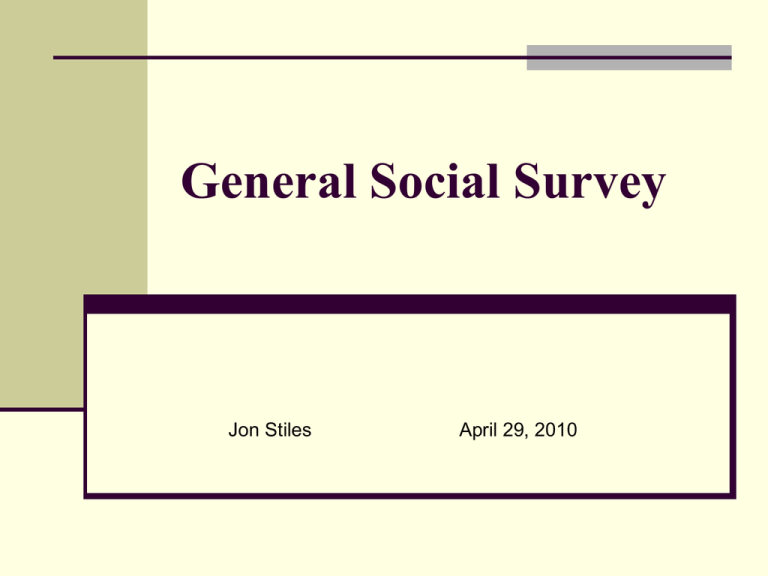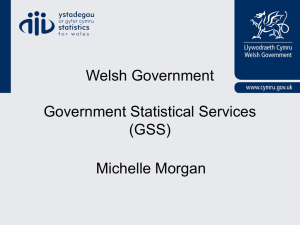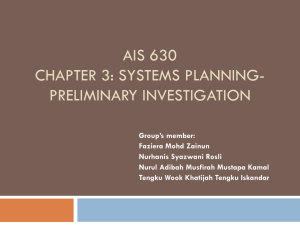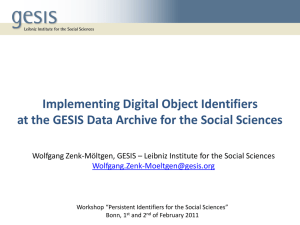
General Social Survey
Jon Stiles
April 29, 2010
General Social Survey
What I’ll talk about today
What is the GSS? (and why should I care?)
What’s on the GSS?
Core Content
Topical Modules
ISSP (Cross-national) Modules
What’s changed over time on the GSS?
How can the data from the GSS be accessed?
What tools exist?
Where’s documentation?
Where can ISSP data be accessed?
What tools exist?
Where’s documentation?
General Social Survey
What is the GSS? (and why should I care?)
The General Social Survey is a nationally representative survey of noninstitutionalized adults in the U.S., providing demographic, attitudinal and
behavioral measures collected using face-to-face interviews beginning in
1972.
The survey was fielded annually between 1972 and 1993 (except for 1979,
1981 and 1992), and biennially after that. The annual surveys had a sample
size of around 1500, and the biennial surveys had a sample size of around
3000.
As of 2008, it had collected data for more than 53,000 respondents, covering
more than 5,000 data items.
It is one of the most widely used data sets in the social sciences. With the
exception of the Census and CPS, the GSS is the most frequently used data
set in the three leading sociology journals. As of December 2007, NORC has
identified it use for nearly 8000 journal articles, 2500 books, and 350
dissertations.
General Social Survey
What is the GSS? (and why should I care?)
The GSS is widely respected, andhas been described as:
• A "national resource" (Alwin, 1988; Firebaugh, 1997; Freese, 2007; NSF, 2007;
Working Group on Large-Scale Data Needs in Luce et al., 1989).
• A “core database” in both sociology (Campbell, 2001) and political science
(Kasse, 2001).
• A “gold standard” (Bobo, 2003; Bradburn, 2007; Healy, 2004; Heath, Fisher, and
Smith, 2005;Miller, Azrael, and Hemenway, 2002; Miller, 2004; NSF, 2006a & 2007;
Saguaro Seminar, 2006;Seligman, 2004).
• The “best data available” (Bolzendahl and Brooks, 2005; Brooks and Cheng, 2001;
Loftus, 2001;Miller and Stark, 2002).
• “Essential for the field of population research” (Population Association of
America, 2007).
• “The premier academic sociology survey” (Teixeira, 2006).
• “The most comprehensive national monitoring of public opinion” (Robinson and
Martin, 2006).
• “The highest-quality omnibus survey done in the United States” (Zipp and
Fenwick, 2006).
• “Benchmarks to which other surveys are compared to assess their
representativeness or the overall accuracy of their results” (Tourangeau, 2003).
General Social Survey
Part II. What’s on the GSS?
General Social Survey
What’s on the GSS?
Core Content – A replicating core of items asked
consistently over time, allowing for analysis of trends.
The core content typically consumes about two-thirds of
the 90 minute GSS interview.
Topical Modules – Usually appear once, and examine
specific topics, attitudes and behaviors in greater depth.
May vary from one or two questions to a longer series. The
topical modules are usually geared to take around 15
minutes.
ISSP (Cross-national) Modules – A series of modules, which
are geared to repeat periodically, and are replicated in many
other countries.
General Social Survey
Core Content
The core sections of the survey emphasizes collection of data on social
trends though exact replication of question wordings over time.
These items fall into two major categories:
socio-demographic/background measures, and;
replicated measurements on social and political attitudes
and behaviors
Core items may be full coverage (asked on all surveys) or rotating.
General Social Survey
Core Content: Demographic and life-course data (self)
Age, Cohort, Astrological sign, Month of Birth, Sex,
Race, Hispanic origin, Ethnic origin, Nativity
Family Composition
Marital Status, age first wed, ever divorced, widowed, separated
Children ever born, age at birth of first child
Labor Force
Employment, unemployment, hours worked, weeks worked
Occupation, Industry, DOT classifications, Union
Superiors/subordinates in workplace
Income
Education, Degree
Family Income
Political Party
Religion
Geography
General Social Survey
Core Content: Demographic and life-course data:
Spouse/Origins
Demographic and life-course data: Spouse/Origins
Household roster (Relationship to HH, age, sex, marital status)
Number of generation in HH, HH type
Proxy reports for: Spouse
Employment, unemployment, hours worked, weeks worked
Occupation, Industry, DOT classifications, Union
Education, Degree
Political Party
Religious preference
Proxy Reports for: Father, Mother, Age 16
Occupation, Industry, Education, Nativity (parents & grandparents)
Family Type
Religion (raised in)
Geography (region, size of place)
General Social Survey
Core Content
Technical
Year, Date of Interview
Form, Ballot, Version
Weights (ADULTS, OVERSAMP, FORMWT, WTSSNR,WTSALL)
Sampcode
Interviewer assessment of respondent cooperativeness, comprehension
Interviewer race, hispanic origin (since 2004)
General Social Survey
Core Content
Social/Political Attitudes & Behaviors
Well-being: Happiness, Marital happiness, Views of others
Religion: attendance, prayer, beliefs (life after death, God, Bible), school prayer
Suicide
Abortion
Gender roles
Family & Children (ideal family size, divorce, birth control, spanking,
gay marriage, ideal child attributes)
Social contacts – relatives, neighbors, friends, bar
Sex – Education in school, premarital, teens, extramarital, gay,
pornography,
Work – security, satisfaction
Class/financial well-being/standard of living/anticipation for future
Political – Votes for president, liberal/conservative, attitudes toward
government intervention, priorities for national spending,
civil liberties, confidence in various social institutions
Racial attitudes, stereotypes
General Social Survey
Topical Modules
1977 Extending scales on Race, Abortion and Feminism
1982 Attitudes on the Military and Military Recruitment
1984 Attitudes on the Military and Military Recruitment
1985 Social Networks
1986 Factorial Vignettes on Welfare
Socio-Political Participation (Partial replication of 1967 Verba-Nie
1987 Study of Political Participation)
1988 Religion
Occupational Prestige (Partial Replication of 1963-1965 NORC
1989 Prestige Study)
1990 Intergroup Relations
1991 Work Organizations
1993 Culture
1994 Family Mobility
1994 Multiculturalism
General Social Survey
Topical Modules
1996 Emotions
1996 Mental Health Bruce Link
1996 Market Exchange/Giving & Volunteering
1996 Gender
1998
/2000
Medical Care
1998 Medical Ethics
1998 Religion
1998 Religion and Health
1998 Culture
1998 Job Experiences
1998 Inter-racial Friendships
General Social Survey
Topical Modules
2000 Multi-Ethnic United States
2000 Information Society
2000 Freedom
2000 Religion
2000 Health Status
2002 Adult Transitions
2002 Employee Compensation
2002 Mental Health
2002 Prejudice
2002 Doctors and Patients
2002 Quality of Working Life
2002 Information Society
2002 Altruism
2002 Arts and Culture
General Social Survey
Topical Modules
2004 Information Society
2004 Guns
2004 Daily Spiritual Experiences
2004 Women and Alcohol Use Experiment
2004 Science
2004 Violence in the Workplace
2004 Genetics
2004 Three-Card Experiment
2004 Attitudes toward Catholics
2004 Altruistic Love
2004 Spiritual Transformations
2004 Negative Life Events
2004 Voluntary Associations/Social Networks
2004 National Pride
General Social Survey
Topical Modules
2006 Quality of Working Life
2006 Science Knowledge and Attitudes
2006 Disability
2006 Shared Capitalism
2006 Congregations
2006 Mental Health Stigma Around the World
2006 Mental Health Replication
2006 Language Use/Internet
2006 Regulation of Firearms
2006 People Known
2006 Trends/Replication
2006 Religion
General Social Survey
Topical Modules
2008
Self-Employment
2008
Jewish Identity
2008
Science Attitudes and Knowledge
2008
Terrorism Preparedness
2008
Global Economics
2008
Sexual Orientation
2008
Clergy Sexual Contact
2008
Cell Phones
2008
Firearms
GESIS –
Leibniz Institute for the Social Sciences
http://www.gesis.org/en/services/data/survey-data/issp
The International Social Survey Programme (ISSP) is a continuous
programme of cross-national collaboration running annual surveys on
topics important for the social sciences. The programme started in 1984
with four founding members - Australia, Germany, Great Britain, and the
United States – and has grown to 45 member countries from all over the
world in 2008.
The ISSP is unique in a number of ways:
• The cross-national collaboration is not ad hoc or intermittent, but continuous.
Thus, the ISSP makes cross-national research a basic part of the national research
agenda of each participating country.
• The programme is based on voluntary co-operation. Major decisions on modules
or questionnaires, on membership or membership obligations are taken by the ISSP
in common, by votes in the ISSP’s general assembly.
• ISSP surveys are designed to serve as replications. Hence, the ISSP offers
two powerful research strategies to study societal processes - by combining a crosstime with a cross-national perspective.
General Social Survey
ISSP Modules
ISSP Topical Modules
Role of Government
1985
1990
1996
2006
Social Networks and Support Systems
1986
2001
Social Equality
1987
1992
1999
2009
Women and Work/Family & Changing Gender Roles
1988
1994
2002
Work Orientation
1989
1997
2005
Religion
1991
1998
2008
Environment
1993
2000
2010
National Identity
1995
2003
Citizenship
2004
Leisure & Sports
2007
General Social Survey
ISSP Modules
45
40
35
30
25
Series2
20
15
10
5
19
85
19
86
19
87
19
88
19
89
19
90
19
91
19
92
19
93
19
94
19
95
19
96
19
97
19
98
19
99
20
00
20
01
20
02
20
03
20
04
20
05
20
06
20
07
0
Number of Countries Participating by Year
General Social Survey
Part III. What’s changed over time?
General Social Survey
What’s changed over time on the GSS?
1972
1976
1980
1984
1988
1992
1996
2000
2004
2008
2012
2004
2008
2012
1970 Sample Frame
Block Quota Sample
Transition to Full Probability sample 1975/1976
1972
1976
1980
1984
1988
1992
1996
2000
General Social Survey
What’s changed over time on the GSS?
1972
1976
1980
1984
1988
1992
1996
2000
2004
2008
2012
2004
2008
2012
1970 Sample Frame
Full probability sample
First Topical Module (1977)
Black Oversample (1982)
1979, 1981 samples dropped
1
1972
1976
1
1980
1984
1988
1992
1996
2000
General Social Survey
What’s changed over time on the GSS?
1972
1976
1980
1984
1988
1992
1996
2000
2004
2008
2012
1980 Sample Frame
Full probability
Annual Topical Modules 1985 on
ISSP modules begin 1985
Black oversample 1987
Shift from across-survey rotation
to split-ballot rotation 1988
1992 sample dropped
1
1972
1976
1
1980
1
1984
1
1
1
1
1988
1
1
1992
1
1996
2000
2004
2008
2012
General Social Survey
What’s changed over time on the GSS?
1972
1976
1980
1984
1988
1992
1996
2000
2004
2008
2012
2004
2008
2012
1990 Sampling Frame
Full probability
1994 Redesign reduced core,
enhanced topical
Biennial – even numbered years,
starting 1994
Pencil & Paper to CAPI 2002
1
1972
1976
1
1980
1
1984
1
1
1
1
1988
1
1
1992
1
2
4
1996
7
5
2000
9
General Social Survey
What’s changed over time on the GSS?
1972
1976
1980
1984
1988
1992
1996
2000
2004
2008
2012
2000 Sampling Frame
Full probability
Sub-sampling for non-response
Spanish language survey 1996
Rotating Panel Design 2008
(New CX 2008 + re-interview 2006)
1
1972
1976
1
1980
1
1984
1
1
1
1
1988
1
1
1992
1
2
4
1996
7
5
2000
9
14
2004
12
9
2008
2012
General Social Survey
How can the data from the GSS be accessed?
What tools exist?
Where’s documentation?
NORC: Data
Questionnaires
Reports (methodological, trends, cross-national)
Restricted Use (geography)
http://www.norc.org/GSS+Website/Documentation/
SDA (Berkeley)
http://sda.berkeley.edu/cgi-bin/hsda?harcsda+gss08
ICPSR
http://www.icpsr.umich.edu/icpsrweb/ICPSR/studies/25962
Roper Center
http://www.ropercenter.uconn.edu/data_access/data/datasets/general
_social_survey.html
General Social Survey
How can the data from the GSS be accessed?
General Social Survey
How can the data from the GSS be accessed?
General Social Survey
How can the data from the GSS be accessed?
General Social Survey
How can the data from the GSS be accessed?
General Social Survey
How can the data from the GSS be accessed?
General Social Survey
Part V. Where can ISSP data be accessed?
GESIS –
Leibniz Institute for the Social Sciences
http://www.gesis.org/en/services/data/survey-data/
GESIS –
Leibniz Institute for the Social Sciences
http://www.gesis.org/en/services/data/survey-data/issp
GESIS –
Leibniz Institute for the Social Sciences
http://www.gesis.org/en/services/data/survey-data/issp
List
of
Years
List of
Countries
GESIS –
Leibniz Institute for the Social Sciences
http://www.gesis.org/en/services/data/survey-data/issp
Selection of any module topic provides listing of years fielded.
Selection of year provides lists of participating countries, sample sizes,
links to original questionnaires in the language it was fielded in,
And……
GESIS –
Leibniz Institute for the Social Sciences
http://www.gesis.org/en/services/data/survey-data/issp
Summary of general topic areas, questions;
when a replication, what items were asked in which years
GESIS –
Leibniz Institute for the Social Sciences
http://www.gesis.org/en/services/data/survey-data/issp
Codebook with country-level detail on PI’s, sample design, response rates,
weighting, marginals, notes.
GESIS –
Leibniz Institute for the Social Sciences
http://www.gesis.org/en/services/data/survey-data/issp
Monitoring report on translation of the survey and possible problems raised
by translation, whether it was pre-tested, whether it was fielded alone or as
part of another survey, whether question ordering was preserved,
sampling/design/field issues (use of quotas, substitution, age cutoffs, mode of
Collection, non-response follow-up, response rates, etc…)
GESIS –
Leibniz Institute for the Social Sciences
http://www.gesis.org/en/services/data/survey-data/issp
Online analysis and download of data, as well as study and variable description
GESIS –
Leibniz Institute for the Social Sciences
http://www.gesis.org/en/services/data/survey-data/issp
Current ISSP practice is to re-administer modules covering a given topic
(e.g. role of government, social inequality, religion) on a 10-year cycle.
Two-thirds of the items in an ISSP module are to be replicated content.







